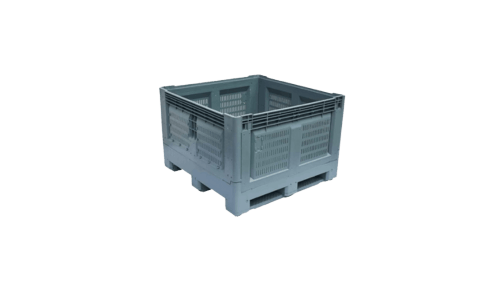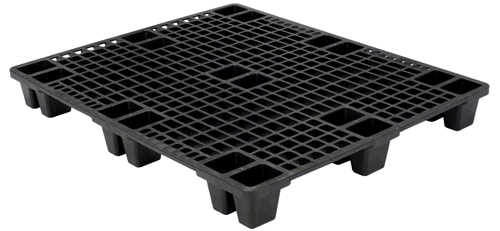

Even if your pallet racking inspection process were entirely compliant and your systems were up to code when you bought them. They still require routine safety reviews to ensure that your workplace or warehouse is safe and secure at all times. Over time, even the sturdiest of racking equipment can experience wear and tear, from loose nuts or bolts to general structural damage.
Eco Pallets Pallet Racking Inspection Checklist
Our pallet racking inspection checklist will help you detect and resolve issues before they risk harming one of your staff members or damaging your valuable inventory. Rack collapses can be fatal. The resulting cleanup (including replacing your damaged property) can cost tens of thousands of dollars and more. Get ahead of a workplace catastrophe and use this list for your next safety review.
General Maintenance
Are your racks straight, level, and plumb?
When a pallet rack is out-of-plumb (leaning) or out-of-straight (bowed), it will have a significantly reduced capacity to bear weight. This type of issue can occur due to several variables, including uneven flooring, poor installation, out-of-place shims, or improper reconfiguration.
If one of your racks looks bent, misaligned, or generally uneven, mark it down as a problem to be resolved immediately. In these cases, a minor collision with a forklift or pallet jack. For example, could yield a much more catastrophic result compared to a well-maintained rack.
Is the metal rusted or corroded?
Rusting or corrosion can be an early warning sign of weakening metal. Some believe that paint is a viable solution to combat rusting, and may even overlook these warning signs if their rack is already painted. But don’t be fooled: paint chips easily, and signs of corroded metal should never be ignored.
Is the rack overloaded?
Pallet racking inspection checklists ensure your racking systems remain a resilient bunch. Because even sturdy structures like these have their limits. That’s what a pallet racking review helps identify. Beams have a rated capacity per pair, but over time, said capacity might drop as the equipment experiences routine wear and tear. The risk, of course, is a devastating collapse.
Before changing loads, make sure to test your system’s capacity: if you’re not able to determine the exact capacity yourself. You can take extra preventive measures by storing the heaviest inventory in the lower bays or on the ground and placing the lightest pallets on top. If you want to take further precautions when it comes to avoiding overload, consider a lightweight option like plastic pallets instead of wood pallets.
Upright Maintenance
Is there any chipped paint?
Chipped paint can be evidence of a past collision with a forklift, pallet jack, or another large piece of equipment. If you notice any chipping, investigate further to ensure the integrity of the structure has not been compromised.
Is there any damage to the horizontal braces, footplates, or base plates?
These are some of the most important elements of your racking system. Common issues with horizontal braces include bending and twisting, while footplates must always be properly attached to the floor. Damage to your base plates may also be a sign of a prior collision. So, you should verify whether the protector did its job or if the column itself sustained damage.
Load Beam Maintenance
Is there any general visible damage?
Be on the lookout for dents, twists, and scrapes while you inspect your load beams. Replacing these parts is easy, and costs next to nothing compared to the aftermath of a collapse.
Is there a normal amount of deflection?
When you place pallets on top of beams, it’s normal for the beams to dip to a certain degree that’s called deflection. However, when you unload the pallets, the beams should return to their regular shape. If they still show signs of deflection while bearing no weight, it’s time to replace them.
Are any small components missing or damaged?
Check to make sure any clips, bolts, and pins (both safety pins and attachment pins) are present and in good shape. While some systems only use one of these methods to ensure a tight fit, others use more than one, so make sure you are familiar with what to look for. If a component is missing or damaged, make sure to replace it immediately.
Pallet Racking Inspection Documentation
The backbone of a detailed pallet racking review is proper documentation. If you see something, say something: mark all of your observations down in a clear and organised manner so they can be turned into actionable tasks. In-depth documentation is also the key to effective tracking. And how often a racking system is inspected, and keeping a record of your recommendations for future reference.
In addition to these guidelines, be sure to familiarise yourself with your pallet racking system manufacturer’s manual for any further considerations that are unique to your equipment.
A routine pallet racking inspection can facilitate a safe working environment while growing the lifespan of your current racking equipment and minimising future repair costs by catching problems early on.
The Australian Standard For Steel Racking: AS 4084-2012
“AS 4084-2012 is the Australian Standard for steel racking, specifically flexible static pallet racking. It covers the minimum requirements for hot-rolled or cold-form steel structural members. It should be installed within a building, outside a building, as well as racking that forms part of the frame of the building.” – Globalind.
Learn more here about these pallet racking regulations from the Council Of Standards Australia and to make sure you’re compliant.
While you’re in the business of remaining budget-friendly and quality-oriented, trust Eco Pallets as your go-to resource for practical, cost-effective pallets and containers.
To find out how we can help your business thrive, contact us today.
Recommended: The Difference Between a Skid and a Pallet.









